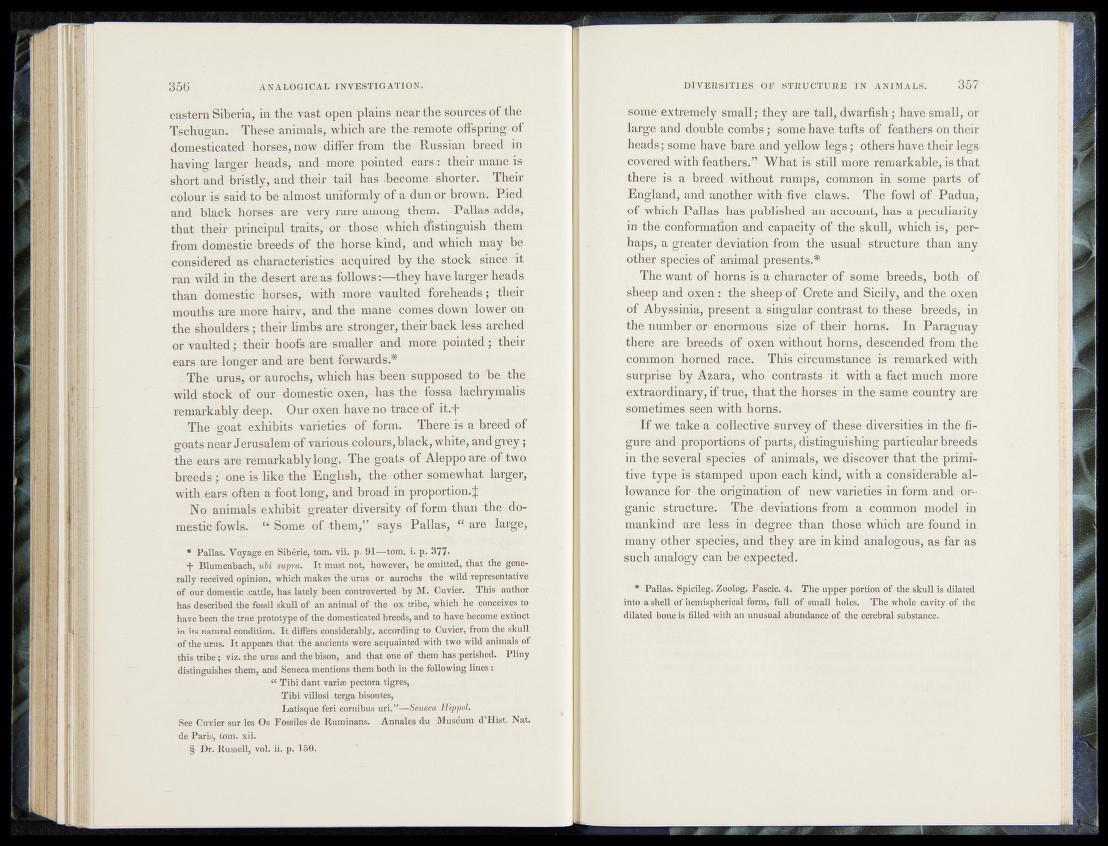
eastern Siberia, in the vast open plains near the sources of the
Tschugan. These animals, which are the .remote offspring of
domesticated horses, now differ from the Russian breed in
halving larger heads, and more pointed ears:: their mane is
short and bristly, and their tail has »become shorter. Their
colour is said to be almost uniformly of a dun or brown; Pied
and black horses are very rare among them. Pallas adds,
th a t their principal traits, or those which distinguish them
from domestic breeds of the .horse kind, and which may be
considered as characteristics acquired by the stock sincent
ran wild in the desert areas follows:—they have larger heads
than domestic horses, with more vaulted foreheads ; their
moiiths are more hairy, and the mane comes down lower on
the shoulders ; their limbs are stronger, their back less arqhed
or vaulted; their hoofs are smaller and more pointed:ftheir
ears are longer and are bent forwards.*
- The urus, or aurochs, which has “been supposed to Tie the
wild stock of our domestic oxeur has the fossa.lachrymalis
remarkably deep. Our oxen have no traceo fit.-f
The ffoat exhibits varieties of form. There is a breed of • -•. -Ö .. ?" ; _ ---- ^ .
goats near Jerusalem of various colours, black, white, and grey:;
the ears are remarkably long. The goats of Aleppo are «of two
breeds ; one is like the English, the other somewhat larger,
with ears often a foot long, and broad in proportion.^
No animals exhibit greater diversity of form than the domestic
fowls. “ Some of them,” says Pallas, “ ate Jarge, •*§
• Pallas. Voyage en Sibérie, tom. yii. p. 91—tom» h p. 377»
•ƒ• Blumenbach, libi supra. It must not, however, be omitted, that the generally
received opinion, which makes the urus or aurochs the wild'representative
of our domestic »cattle, has lately been controverted by M. Cuvier. This author
has described the fossil skull of an animal of the Ox tribe, which he .conceives to
hove been the-true prototype of the domesticated breeds, and to havé become extinct
in its natural condition: Tt differs considerably, according to Cuvier, from the skull
of the urus. It appears that the ancients were acquainted -with two wild animals of
this tribe ^ viz. the urus and the bison,_ and that one Of them has .perished. Pliny
distinguishes them, and Seneca mentions them both in the following lines :
H Tibi dant variæ peetora tigres,,
Tibi villosi terga bisontes,
Latisque feri cornibus uri.”— Seneca Hippol.
See Cuvier sur les Os Fossiles de Ruminans. Annales du Muséum d'Hist. Nat.
de Paris, torn. xii.
§ JDr. Russell, vol. ii. p. ISO.
some extremely small; they are tall, dwarfish; have small, or
large and'dtnrble combs; some have tufts of feathers on their
heads; some have bare and yellow lègs; others have their legs
covered with feathers.” What is still more remarkable, is that
there is. breed without rumps, Corhmon in some parts of
England, and another with^five claws. The fowl of Padua,
of which Pallas has published an account, has a peculiarity
in the conformation and capacity of the skull,- which is, perhaps,
a greater deviation from the usual- structure than any
other speciesfof animal presents.*
The want of horns is a character some breeds, both of
sheep and oxen :* the sheep of'"0rete and Sicily,- and the oxen
of Abyssinia, present a singular'contrast to these ^breeds, in
the-number or enormous «izèilaf their horaS.. In Paraguay
there are breeds of. oxen without horns, descended from the-
common horned race. This circumstance is remarked with
surprise by/Azara, who: contrasts it. with a fact much more
extraordinary, if true, that the horses in the same* country are
sometimes seen with horns.
If we take a collective survey of these diversities in the figure
ahd. proportions of parts, distinguishing particular breeds
in the several species of animals, we^diseover that the primitive
Hype4 is stamped upon each kind, with a considerable allowance
for- the origination of new varieties in form and organic
structures The. deviations from a common model in
mankind are less* in 'degree- than those which are found in
many other specie!,,and they are in kind analogous, as far as
such analogy can be expected.
* Pallas. Spicileg. Zoolog. Fascic. 4. The upper portion of the skull is dilated
into a shell of hemispherical form, full of small holes. ; >»The.whole cavity of the
dilated bone is filled with an unusual abundance of the cerebral substance.